著名的中国文化的象征(英文)
中国的一个象征英语作文
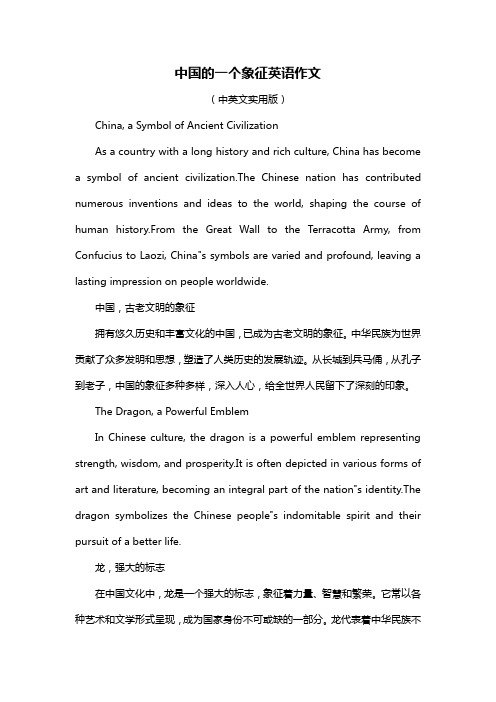
中国的一个象征英语作文(中英文实用版)China, a Symbol of Ancient CivilizationAs a country with a long history and rich culture, China has become a symbol of ancient civilization.The Chinese nation has contributed numerous inventions and ideas to the world, shaping the course of human history.From the Great Wall to the Terracotta Army, from Confucius to Laozi, China"s symbols are varied and profound, leaving a lasting impression on people worldwide.中国,古老文明的象征拥有悠久历史和丰富文化的中国,已成为古老文明的象征。
中华民族为世界贡献了众多发明和思想,塑造了人类历史的发展轨迹。
从长城到兵马俑,从孔子到老子,中国的象征多种多样,深入人心,给全世界人民留下了深刻的印象。
The Dragon, a Powerful EmblemIn Chinese culture, the dragon is a powerful emblem representing strength, wisdom, and prosperity.It is often depicted in various forms of art and literature, becoming an integral part of the nation"s identity.The dragon symbolizes the Chinese people"s indomitable spirit and their pursuit of a better life.龙,强大的标志在中国文化中,龙是一个强大的标志,象征着力量、智慧和繁荣。
中国传统文化象征(英文介绍)

City
9
Forbidden City
• The Forbidden City, also known as the Palace Museum , locates in the center of Beijing. • The Palace Museum start to set up in A.D.1406, it has the size courtyard more than 90s and the house contain 980 and add up to 8704. • The Palace Museum has 4 doors, center door Wu door, east door Donghua door, west door Xihua door, north door Shengwu door.
10
Beijing Opera
13
Beijing Opera
• Beijing Opera is a form of traditional Chinese theatre which combines music, vocal performance, mime, dance, and acrobatics. Sheng Dan • Although it is called Beijing opera (Beijing theatre style), its origins are in the southern Anhui and eastern Hubei. • The roles on the Beijing opera stage fall into four categories -- Sheng, Dan, Jing and Chou.
中国文化象征龙英语作文
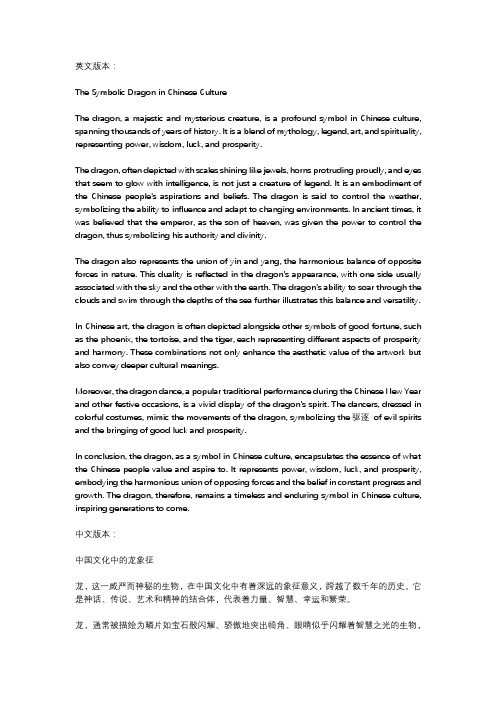
英文版本:The Symbolic Dragon in Chinese CultureThe dragon, a majestic and mysterious creature, is a profound symbol in Chinese culture, spanning thousands of years of history. It is a blend of mythology, legend, art, and spirituality, representing power, wisdom, luck, and prosperity.The dragon, often depicted with scales shining like jewels, horns protruding proudly, and eyes that seem to glow with intelligence, is not just a creature of legend. It is an embodiment of the Chinese people's aspirations and beliefs. The dragon is said to control the weather, symbolizing the ability to influence and adapt to changing environments. In ancient times, it was believed that the emperor, as the son of heaven, was given the power to control the dragon, thus symbolizing his authority and divinity.The dragon also represents the union of yin and yang, the harmonious balance of opposite forces in nature. This duality is reflected in the dragon's appearance, with one side usually associated with the sky and the other with the earth. The dragon's ability to soar through the clouds and swim through the depths of the sea further illustrates this balance and versatility.In Chinese art, the dragon is often depicted alongside other symbols of good fortune, such as the phoenix, the tortoise, and the tiger, each representing different aspects of prosperity and harmony. These combinations not only enhance the aesthetic value of the artwork but also convey deeper cultural meanings.Moreover, the dragon dance, a popular traditional performance during the Chinese New Year and other festive occasions, is a vivid display of the dragon's spirit. The dancers, dressed in colorful costumes, mimic the movements of the dragon, symbolizing the驱逐of evil spirits and the bringing of good luck and prosperity.In conclusion, the dragon, as a symbol in Chinese culture, encapsulates the essence of what the Chinese people value and aspire to. It represents power, wisdom, luck, and prosperity, embodying the harmonious union of opposing forces and the belief in constant progress and growth. The dragon, therefore, remains a timeless and enduring symbol in Chinese culture, inspiring generations to come.中文版本:中国文化中的龙象征龙,这一威严而神秘的生物,在中国文化中有着深远的象征意义,跨越了数千年的历史。
能代表中国文化的东西英语作文

能代表中国文化的东西英语作文Chinese culture is rich and diverse, with a long history and many traditions that continue to influence peoplearound the world. There are many things that can represent Chinese culture, but some of the most iconic and well-known include the Great Wall, Chinese calligraphy, traditional Chinese tea, and the Chinese zodiac.The Great Wall is a symbol of China's ancientcivilization and is one of the most impressivearchitectural feats in history. It represents the strength and determination of the Chinese people, and is a testament to their ability to work together to achieve great things.Chinese calligraphy is another important aspect of Chinese culture, and is considered a high art form in China. It has been practiced for thousands of years and is a wayfor people to express themselves through writing. Eachstroke of the brush is carefully considered, and the art of calligraphy is highly respected in Chinese society.Traditional Chinese tea is also a significant part of Chinese culture, and has a long history dating backthousands of years. It is not just a drink, but a way of life in China, and is often used in traditional Chinese medicine and in social and cultural gatherings.The Chinese zodiac is another important cultural symbol, and is based on a twelve-year cycle, with each year represented by a different animal. The zodiac is an important part of Chinese culture, and is used to determine a person's personality, compatibility with others, and even their future.These are just a few examples of the many things that can represent Chinese culture. From the ancient Great Wall to the intricate art of calligraphy, to the traditional practice of drinking tea and the symbolism of the Chinese zodiac, Chinese culture is rich and diverse, and continues to have a profound impact on people around the world.中国文化是丰富多彩的,有着悠久的历史和许多传统,继续影响着世界各地的人们。
China_中国文化PPT英文介绍
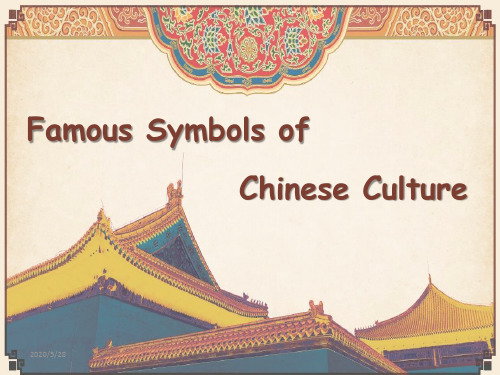
长城是一堵墙的名字。它首先来自秦朝的时候。秦始皇于公元前221年统 一中国,他想保护中国的北部边境,于是他命令他的士兵建立边境墙。
as body/mind techniques.
传统形式的医学3世纪以来一直在中国使用。中医是非常全面的,主要集中在 “阴阳”的平衡以及身心。中医主要由天然草药,以及身体/精神技术组成。
Traditional Medicine
Traditional medicine revolves the principles of Yin and Yang, which are the opposites found in everything, such as day (Yang) or night (Yin) .
现在,长城已成为名胜古迹。我们都知道著名的中国谚语:“不到长城非好 汉。”
2.Chinese Character
According to legend, a man called Cang Jie(仓颉) had four eyes, observed all directions. And he invented a symbolic system called Zi — Chinese characters.
中国功夫是中国传统的体力活动与数千万年的历史。作为中国文化遗 产的一种珍贵的元素,中国功夫也赢得了很好的声誉并且被世界各国的人 喜爱。因它深刻的意义和东方的特点,涵盖了神秘的面纱。
中国传统文化介绍(英文版)

栏目索引与介绍•当前位置: 主页/•中外文化/中国文化随着中国加入世界贸易组织,中国将进一步对外开放,中国经济与世界经济更加融合。
因此,将中华民族悠久的历史和灿烂的文化介绍给世界各国人民是所有英语爱好者应尽的责任。
开辟这个栏目,就是为了适应对外宣传的需要。
我们将在此介绍中国历史、音乐、绘画、考古、旅游、经济、宗教等方面的情况。
那些从事中国文化教学与研究的师生会在这里找到一些参考资料和英语表达方式。
中国文化知识漫谈(中文)中国文化美国行(新闻报道与背景介绍)Culture Relics文化古迹Travel Features旅游Wushu/Qigong武术与气功Opera/Theatre戏曲Galleries/Museums美术馆与博物馆Peking Opera中国京剧Events/Festivals节日与民俗Local Opera中国地方戏Chinese New Year's Day中国新年来历与24节气Dance Drama and Ballet中国舞剧与芭蕾Traditions of Chinese New Year中国新年除夕习俗Modern Chinese Drama中国话剧Do's and Don'ts of Chinese New Year 中国新年禁忌Acrobatics, Puppet and Shadow Shows杂技、木偶戏与皮影The History of Lion Dance中国舞狮Quyi Performances中国曲艺表演The History of Fireworks中国鞭炮Paintings/Handicrafts绘画与工艺品Lantern Festival元宵节成语典故一 (三国演义、西游记)Brithday of Confucius孔子生日成语典故二Birthday of Mazoo妈祖生日成语典故三Dragon Boat Festival端午节成语典故四Moon Festival中秋节中国古代简史中国文学(包括古文、近代、现代与当代文学以及文化传统,作家传记)中国诗歌英译 (请综合训练中翻译技巧栏目)中国旅游《旅游英语》网络课程中国旅游十大特色中国西藏北京景点天坛中国美食故宫中国十二生肖:12 Taditional Zodiacs M usic音乐RAM HORSE Solo Recordings中国音乐独奏MONKEY ROOSTER CollectedRecordings中国音乐集锦SNAKE DRAGON TraditionalChinese中国传统乐器与音乐InstrumentalmusicDOG PIG Classical Music中国古典音乐OX TIGERRABBIT RAT中国文化知识漫谈(一)文化的含义什么叫文化?《易经》上说:“观乎天文,以察时变,观乎人文,以化成天下。
中国文化 中英文对照
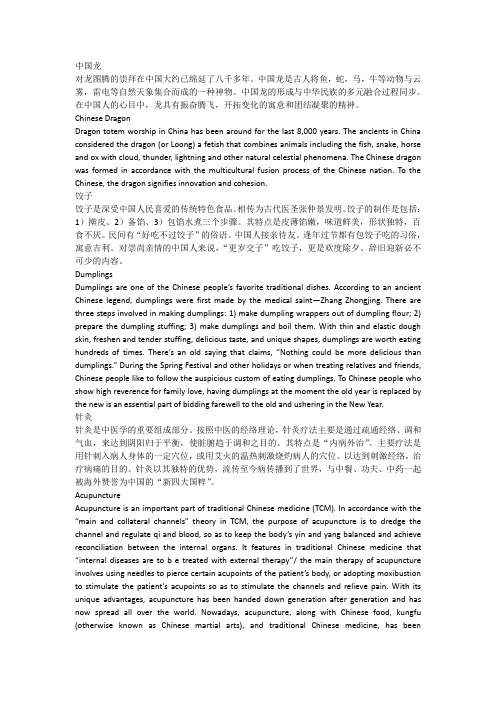
中国龙对龙图腾的崇拜在中国大约已绵延了八千多年。
中国龙是古人将鱼,蛇,马,牛等动物与云雾,雷电等自然天象集合而成的一种神物。
中国龙的形成与中华民族的多元融合过程同步。
在中国人的心目中,龙具有振奋腾飞,开拓变化的寓意和团结凝聚的精神。
Chinese DragonDragon totem worship in China has been around for the last 8,000 years. The ancients in China considered the dragon (or Loong) a fetish that combines animals including the fish, snake, horse and ox with cloud, thunder, lightning and other natural celestial phenomena. The Chinese dragon was formed in accordance with the multicultural fusion process of the Chinese nation. To the Chinese, the dragon signifies innovation and cohesion.饺子饺子是深受中国人民喜爱的传统特色食品。
相传为古代医圣张仲景发明。
饺子的制作是包括:1)擀皮、2)备馅、3)包馅水煮三个步骤。
其特点是皮薄馅嫩,味道鲜美,形状独特,百食不厌。
民间有“好吃不过饺子”的俗语。
中国人接亲待友。
逢年过节都有包饺子吃的习俗,寓意吉利。
对崇尚亲情的中国人来说,“更岁交子”吃饺子,更是欢度除夕、辞旧迎新必不可少的内容。
DumplingsDumplings are one of the Chinese people’s favorite traditional dishes. According to an ancient Chinese legend, dumplings were first made by the medical saint—Zhang Zhongjing. There are three steps involved in making dumplings: 1) make dumpling wrappers out of dumpling flour; 2) prepare the dumpling stuffing; 3) make dumplings and boil them. With thin and elastic dough skin, freshen and tender stuffing, delicious taste, and unique shapes, dumplings are worth eating hundreds of times. There’s an old saying that claims, “Nothing could be more delicious than dumplings.” During the Spring Festival and other holidays or when treating relatives and friends, Chinese people like to follow the auspicious custom of eating dumplings. To Chinese people who show high reverence for family love, having dumplings at the moment the old year is replaced by the new is an essential part of bidding farewell to the old and ushering in the New Year.针灸针灸是中医学的重要组成部分。
英语中的中国传统文化
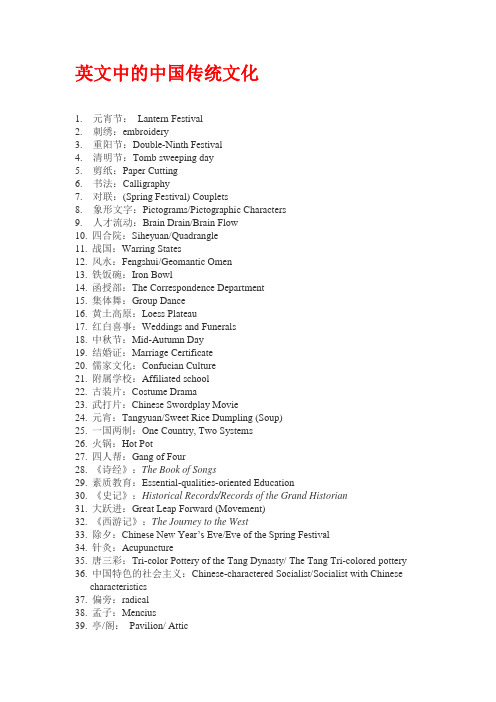
英文中的中国传统文化1.元宵节:Lantern Festival2.刺绣:embroidery3.重阳节:Double-Ninth Festival4.清明节:Tomb sweeping day5.剪纸:Paper Cutting6.书法:Calligraphy7.对联:(Spring Festival) Couplets8.象形文字:Pictograms/Pictographic Characters9.人才流动:Brain Drain/Brain Flow10.四合院:Siheyuan/Quadrangle11.战国:Warring States12.风水:Fengshui/Geomantic Omen13.铁饭碗:Iron Bowl14.函授部:The Correspondence Department15.集体舞:Group Dance16.黄土高原:Loess Plateau17.红白喜事:Weddings and Funerals18.中秋节:Mid-Autumn Day19.结婚证:Marriage Certificate20.儒家文化:Confucian Culture21.附属学校:Affiliated school22.古装片:Costume Drama23.武打片:Chinese Swordplay Movie24.元宵:Tangyuan/Sweet Rice Dumpling (Soup)25.一国两制:One Country, Two Systems26.火锅:Hot Pot27.四人帮:Gang of Four28.《诗经》:The Book of Songs29.素质教育:Essential-qualities-oriented Education30.《史记》:Historical Records/Records of the Grand Historian31.大跃进:Great Leap Forward (Movement)32.《西游记》:The Journey to the West33.除夕:Chinese New Year’s Eve/Eve of the Spring Festival34.针灸:Acupuncture35.唐三彩:Tri-color Pottery of the Tang Dynasty/The Tang Tri-colored pottery36.中国特色的社会主义:Chinese-charactered Socialist/Socialist with Chinesecharacteristics37.偏旁:radical38.孟子:Mencius39.亭/阁:Pavilion/ Attic40.大中型国有企业:Large and Medium-sized State-owned Enterprises41.火药:gunpowder42.农历:Lunar Calendar43.印/玺:Seal/Stamp44.物质精神文明建设:The Construction of Material Civilization and SpiritualCivilization45.京剧:Beijing Opera/Peking Opera46.秦腔:Crying of Qin People/Qin Opera47.太极拳:Tai Chi48.独生子女证:The Certificate of One-child49.天坛:Altar of Heaven in Beijing50.小吃摊:Snack Bar/Snack Stand51.红双喜:Double Happiness52.政治辅导员:Political Counselor/School Counselor53.春卷:Spring Roll(s)54.莲藕:Lotus Root55.追星族:Star Struck56.故宫博物院:The Palace Museum57.相声:Cross-talk/Comic Dialogue58.下岗:Lay off/Laid off59.北京烤鸭:Beijing Roast Duck60.高等自学考试:Self-taught Examination of Higher Education61.烟花爆竹:fireworks and firecracker62.敦煌莫高窟:Mogao Caves63.电视小品:TV Sketch/TV Skit64.香港澳门同胞:Compatriots from Hong Kong and Macao65.文化大革命:Cultural Revolution66.长江中下游地区:The Mid-low Reaches of Yangtze River67.门当户对:Perfect Match/Exact Match68.《水浒》:Water Margin/Outlaws of the Marsh69.中外合资企业:Joint Ventures70.文房四宝(笔墨纸砚):"The Four Treasure of the Study" "Brush, Inkstick, Paper,and Inkstone",。
英文介绍中国文化、节日、符号、象征
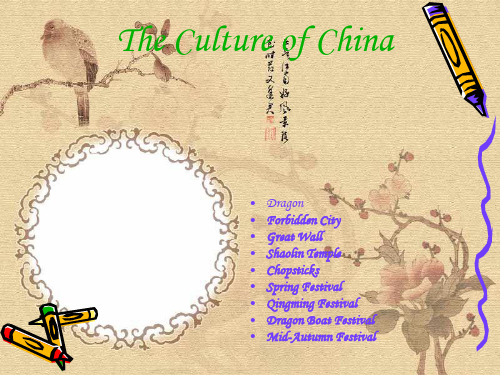
dragon
• Chinese dragons are legendary creatures in Chinese mythology and folklore.In Chinese art, dragons are typically portrayed as long, scaled, serpentine creatures with four legs. In yin and yang terminology(术语), a dragon is yang and complements a yin fenghuang “Chinese phoenix(长生鸟)". • In Chinese daily language, excellent and outstanding people are compared to the dragon while incapable people with no achievements are compared with other, disesteemed creatures, such as the worm. A number of Chinese proverbs and idioms feature references to • the dragon, for example: “Hoping one‘s son will • become a dragon” (望子成龙). • Many Chinese people often use the term • “Descendants of the Dragon” (龙的传人) • as a sign of ethnic identity, as part of a trend • started in the 1970s when different Asian • nationalities were looking for animal • symbols for representations.The wolf • was used among the Mongols(蒙古), the monkey among
中国文化之宝英语
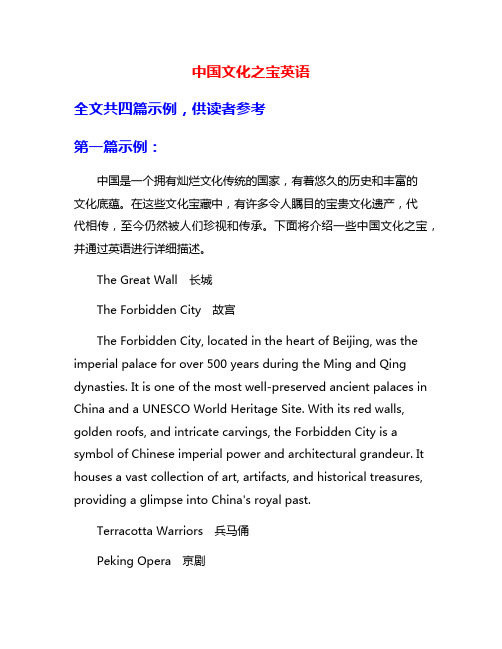
中国文化之宝英语全文共四篇示例,供读者参考第一篇示例:中国是一个拥有灿烂文化传统的国家,有着悠久的历史和丰富的文化底蕴。
在这些文化宝藏中,有许多令人瞩目的宝贵文化遗产,代代相传,至今仍然被人们珍视和传承。
下面将介绍一些中国文化之宝,并通过英语进行详细描述。
The Great Wall 长城The Forbidden City 故宫The Forbidden City, located in the heart of Beijing, was the imperial palace for over 500 years during the Ming and Qing dynasties. It is one of the most well-preserved ancient palaces in China and a UNESCO World Heritage Site. With its red walls, golden roofs, and intricate carvings, the Forbidden City is a symbol of Chinese imperial power and architectural grandeur. It houses a vast collection of art, artifacts, and historical treasures, providing a glimpse into China's royal past.Terracotta Warriors 兵马俑Peking Opera 京剧Chinese Calligraphy 中国书法Tea Culture 茶文化Conclusion 总结以上就是关于【中国文化之宝英语】的文章,希望能够为您提供一些有用的信息。
谢谢阅读!第二篇示例:中国文化源远流长,拥有众多珍贵的文化遗产,代代相传。
中国文化 英文介绍(通用3篇)

中国文化英文介绍(通用3篇)关于中国文化的英文文章篇一Lucky number is part of our cultureTo my way of thinking, the so-called lucky number represents the characteristics of our culture. We Chinese have a tradition: whenever we have important things to do, we always select the day we think lucky. Such as: the “10.10.10” day (October 10, 2010), we regard it as the prefect day. For in our culture, “10” as a very lucky number means everything is perfect.This tradition is gradually formed in history. As we all know, china have a very long history. The nature is very sacred then, and our ancestors try their best in order to gain its help, hoping everything run smooth. So when they were to do things, they usually choose something which indicates good fortune. As the time passes, this habit slowly becomes a tradition, and gradually expands every aspect of life. For example, Chinese people like wear the red clothes, because in our eyes the red indicates positive, smooth, prosperous.Among this, the lucky number is the especial example. Now the number seems to appear everywhere in our daily life. Such as: our telephone number, various bank card number, ID number, VIP card number, house number and so on. The number four looked as unlucky, for its pronunciation sound as the word “death” in Chinese. So is the number seven. However, six, nine, ten are lucky numbers. Affected by this culture, most of us prefer to use the so-called lucky numbers. Therefore there are lots of couples choose the”8.8.8”“9.9.9””10.10.10”day when they marry.All in all, the lucky number is part of our culture. All things we can do are holding a respect and accept of attitude to it.中国文化英文介绍篇二京剧脸谱(Beijing opera types of facial makeup in operas)Beijing opera types of facial makeup in operas, is a special feature of a national cosmetic. As each historical figure or a certain type of person has an approximate spectral type, like sing, play music to the music, so called “types of facial makeup in operas”。
中国著名象征英文作文
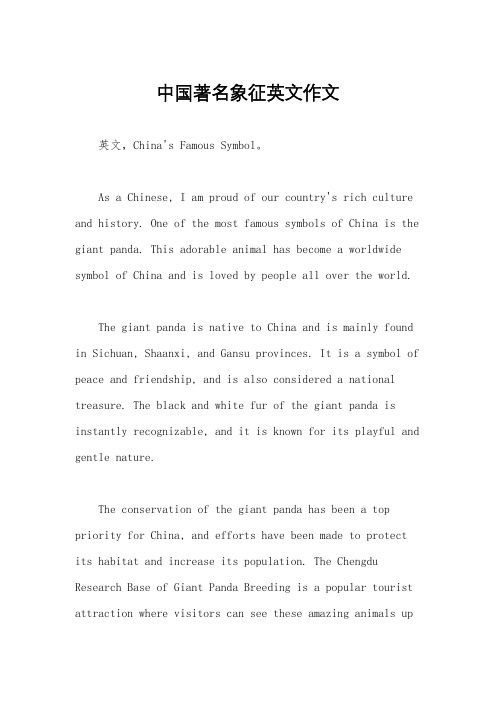
中国著名象征英文作文英文,China's Famous Symbol。
As a Chinese, I am proud of our country's rich culture and history. One of the most famous symbols of China is the giant panda. This adorable animal has become a worldwide symbol of China and is loved by people all over the world.The giant panda is native to China and is mainly found in Sichuan, Shaanxi, and Gansu provinces. It is a symbol of peace and friendship, and is also considered a national treasure. The black and white fur of the giant panda is instantly recognizable, and it is known for its playful and gentle nature.The conservation of the giant panda has been a top priority for China, and efforts have been made to protect its habitat and increase its population. The Chengdu Research Base of Giant Panda Breeding is a popular tourist attraction where visitors can see these amazing animals upclose.In addition to the giant panda, there are many other symbols of China, such as the Great Wall, the Forbidden City, and the Terracotta Warriors. Each of these symbols represents a different aspect of China's rich cultural heritage.中文,中国著名象征。
中英文中国文化象征介绍
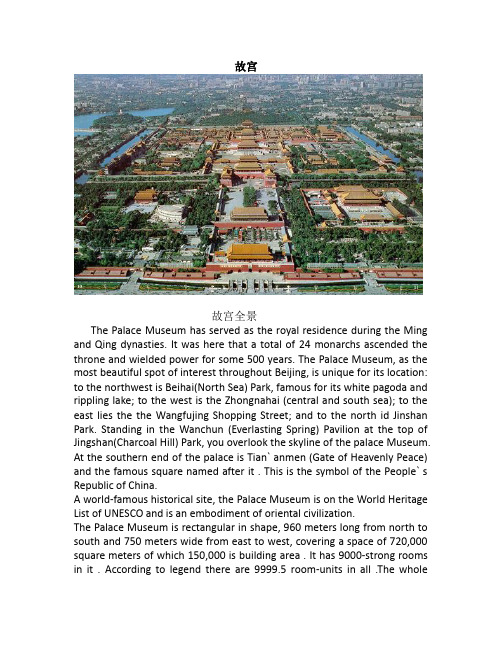
故宫故宫全景The Palace Museum has served as the royal residence during the Ming and Qing dynasties. It was here that a total of 24 monarchs ascended the throne and wielded power for some 500 years. The Palace Museum, as the most beautiful spot of interest throughout Beijing, is unique for its location: to the northwest is Beihai(North Sea) Park, famous for its white pagoda and rippling lake; to the west is the Zhongnahai (central and south sea); to the east lies the the Wangfujing Shopping Street; and to the north id Jinshan Park. Standing in the Wanchun (Everlasting Spring) Pavilion at the top of Jingshan(Charcoal Hill) Park, you overlook the skyline of the palace Museum. At the southern end of the palace is Tian` anmen (Gate of Heavenly Peace) and the famous square named after it . This is the symbol of the People` s Republic of China.A world-famous historical site, the Palace Museum is on the World Heritage List of UNESCO and is an embodiment of oriental civilization.The Palace Museum is rectangular in shape, 960 meters long from north to south and 750 meters wide from east to west, covering a space of 720,000 square meters of which 150,000 is building area . It has 9000-strong rooms in it . According to legend there are 9999.5 room-units in all .The wholecompound is enclosed by a 10-meter-hign wall and is accessed through four entrances, namely, the meridian Gate in the south ,the Gate of Military Prowess in the north, Donghua(Eastern Flowery ) Gate in the north, Donghua ( Eastern Flowery) Gate in the east and Xihua(Western Flowery ) Gate in the west. On each corner there is a turret consisted of 9 roof beams, 18 pillars and 72 ridge . Encircling the compound there is a 3,800-meter-long and 52 meter-wide moat, making the Palace Museum a self-defensive city-within-a city.译文:故宫旧称紫禁城。
有关中国古代名人的英语四六级作文模板
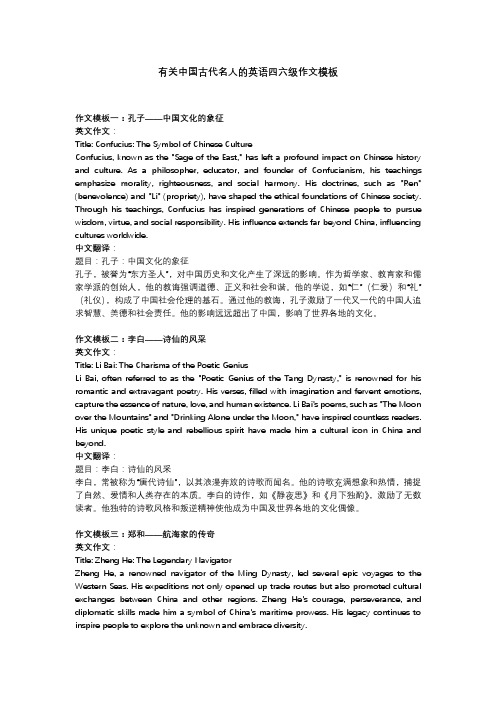
有关中国古代名人的英语四六级作文模板作文模板一:孔子——中国文化的象征英文作文:Title: Confucius: The Symbol of Chinese CultureConfucius, known as the "Sage of the East," has left a profound impact on Chinese history and culture. As a philosopher, educator, and founder of Confucianism, his teachings emphasize morality, righteousness, and social harmony. His doctrines, such as "Ren" (benevolence) and "Li" (propriety), have shaped the ethical foundations of Chinese society. Through his teachings, Confucius has inspired generations of Chinese people to pursue wisdom, virtue, and social responsibility. His influence extends far beyond China, influencing cultures worldwide.中文翻译:题目:孔子:中国文化的象征孔子,被誉为“东方圣人”,对中国历史和文化产生了深远的影响。
作为哲学家、教育家和儒家学派的创始人,他的教诲强调道德、正义和社会和谐。
他的学说,如“仁”(仁爱)和“礼”(礼仪),构成了中国社会伦理的基石。
通过他的教诲,孔子激励了一代又一代的中国人追求智慧、美德和社会责任。
中国文化标志性建筑英语作文高中
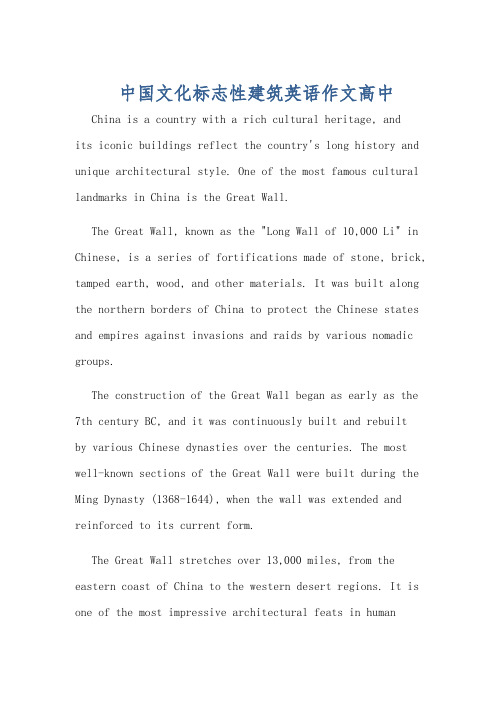
中国文化标志性建筑英语作文高中China is a country with a rich cultural heritage, andits iconic buildings reflect the country's long history and unique architectural style. One of the most famous cultural landmarks in China is the Great Wall.The Great Wall, known as the "Long Wall of 10,000 Li" in Chinese, is a series of fortifications made of stone, brick, tamped earth, wood, and other materials. It was built along the northern borders of China to protect the Chinese states and empires against invasions and raids by various nomadic groups.The construction of the Great Wall began as early as the 7th century BC, and it was continuously built and rebuiltby various Chinese dynasties over the centuries. The most well-known sections of the Great Wall were built during the Ming Dynasty (1368-1644), when the wall was extended and reinforced to its current form.The Great Wall stretches over 13,000 miles, from the eastern coast of China to the western desert regions. It is one of the most impressive architectural feats in humanhistory and is considered a symbol of China's strength, perseverance, and ingenuity.The Great Wall has become a symbol of China and is recognized worldwide as a UNESCO World Heritage Site. It attracts millions of visitors from around the world each year, who come to marvel at its grandeur and learn about its history.中国是一个拥有丰富文化遗产的国家,其标志性建筑反映了这个国家悠久的历史和独特的建筑风格。
可以代表中国的文化英语作文
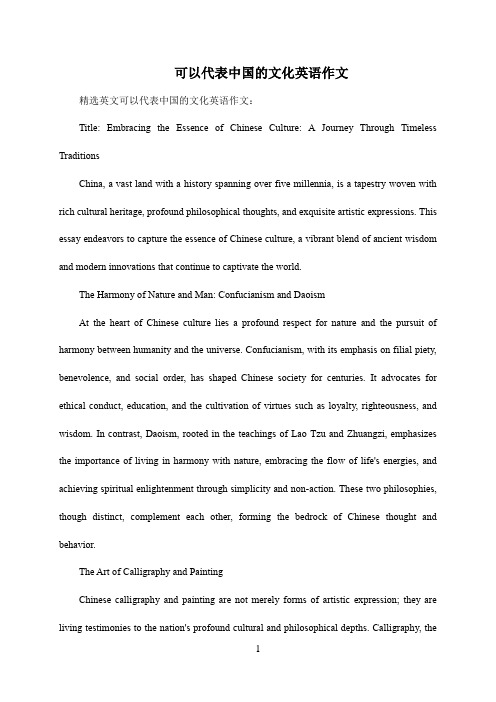
可以代表中国的文化英语作文精选英文可以代表中国的文化英语作文:Title: Embracing the Essence of Chinese Culture: A Journey Through Timeless TraditionsChina, a vast land with a history spanning over five millennia, is a tapestry woven with rich cultural heritage, profound philosophical thoughts, and exquisite artistic expressions. This essay endeavors to capture the essence of Chinese culture, a vibrant blend of ancient wisdom and modern innovations that continue to captivate the world.The Harmony of Nature and Man: Confucianism and DaoismAt the heart of Chinese culture lies a profound respect for nature and the pursuit of harmony between humanity and the universe. Confucianism, with its emphasis on filial piety, benevolence, and social order, has shaped Chinese society for centuries. It advocates for ethical conduct, education, and the cultivation of virtues such as loyalty, righteousness, and wisdom. In contrast, Daoism, rooted in the teachings of Lao Tzu and Zhuangzi, emphasizes the importance of living in harmony with nature, embracing the flow of life's energies, and achieving spiritual enlightenment through simplicity and non-action. These two philosophies, though distinct, complement each other, forming the bedrock of Chinese thought and behavior.The Art of Calligraphy and PaintingChinese calligraphy and painting are not merely forms of artistic expression; they are living testimonies to the nation's profound cultural and philosophical depths. Calligraphy, theart of writing Chinese characters with beauty and elegance, embodies the harmony between form and spirit, conveying the artist's emotions and personality through the strokes of the brush. Similarly, traditional Chinese painting, whether in landscape, flower-and-bird, or figure styles, captures the essence of nature and the human experience, often incorporating Daoist and Buddhist philosophies. These arts have evolved over time, yet they remain deeply rooted in Chinese culture, reflecting the nation's unique aesthetic sensibilities and spiritual pursuits.The Celebration of Festivals and HolidaysChinese culture is also known for its vibrant celebrations and festivals, each imbued with rich historical and mythological significance. The Spring Festival, also known as Chinese New Year, marks the turn of the lunar calendar and is celebrated with grand family reunions, fireworks, and the exchange of red envelopes filled with money, symbolizing good fortune and prosperity. Other notable festivals include the Mid-Autumn Festival, celebrated with mooncakes and family gatherings under the full moon, and the Dragon Boat Festival, commemorating the life and teachings of the ancient poet Qu Yuan and featuring dragon boat races and rice dumplings. These festivals not only strengthen family bonds but also reflect the Chinese people's reverence for nature, ancestors, and tradition.The Influence of Chinese CuisineChinese cuisine, with its myriad regional variations and cooking techniques, is another testament to the nation's rich cultural heritage. From the spicy delicacies of Sichuan to the delicate flavors of Cantonese cuisine, Chinese food is renowned for its intricate balance of flavors, textures, and colors. The use of traditional ingredients like soy sauce, rice wine, andginger, as well as cooking methods like stir-frying, steaming, and braising, have given birth to a vast array of dishes that have captivated diners worldwide. Chinese cuisine is not just about taste; it is a reflection of the country's history, geography, and social customs.ConclusionChinese culture is a vast and diverse ocean, teeming with treasures that continue to inspire and enchant. From its harmonious philosophical foundations to the exquisite arts of calligraphy and painting, from the festive celebrations that bind families together to the delectable dishes that tantalize the taste buds, every aspect of Chinese culture embodies a profound respect for tradition and a relentless pursuit of excellence. As China continues to evolve and embrace the world, its rich cultural heritage remains a beacon of light, illuminating the path forward for future generations.中文对照翻译:书名:拥抱中国文化精髓:穿越永恒传统之旅中国幅员辽阔,有着五千年的历史,是一幅文化底蕴深厚、哲学思想深刻、艺术表现力精湛的织锦。
China 中国文化英文介绍-文档资料
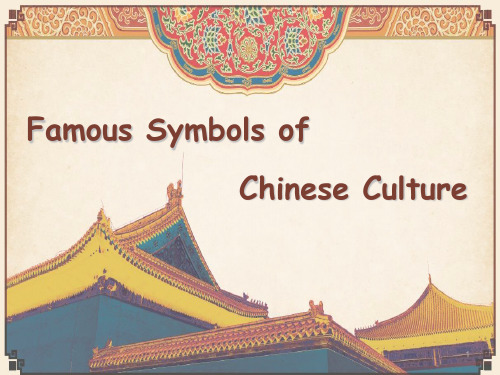
1
Directory
· The Great Wall · Chinese Character · Chinese Medicine · Chinese Kung fu · Giant Panda
2
The Great Wall of China is one of the wonders of the world. It is one of the few man-made objects on earth that can be seen on the moon. All the work was done by
Now the Great Wall has become a place of interest. We all know the famous Chinese saying: “He who does not reach the Great Wall is not a true man.”
长城是一堵墙的名字。它首先来自秦朝的时候。秦始皇于公元前221年统 一中国,他想保护中国的北部边境,于是他命令他的士兵建立边境墙。
熊猫(学名:Ailuropoda melanoleuca),是世界上最珍贵的动物之一。 它是如此罕见并被称为“中国国宝”。熊猫是中国特有的一种动物,它们 生活在四川、陕西等周边山区。
16
Thank you!
Designer: Soph眼睛, 能观察到各个方向。他发明了一种象征性的 系统称为字——汉字。
周朝时期,在陶器和铸造的青铜器上也 发现一些文字,被称为青铜脚本。
6
Oracle
Da
Li
Regular
Cursive
中国非遗英文作文
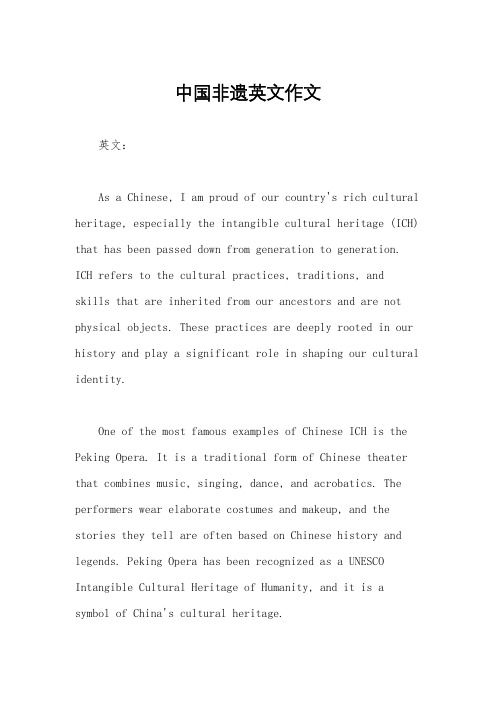
中国非遗英文作文英文:As a Chinese, I am proud of our country's rich cultural heritage, especially the intangible cultural heritage (ICH) that has been passed down from generation to generation. ICH refers to the cultural practices, traditions, andskills that are inherited from our ancestors and are not physical objects. These practices are deeply rooted in our history and play a significant role in shaping our cultural identity.One of the most famous examples of Chinese ICH is the Peking Opera. It is a traditional form of Chinese theater that combines music, singing, dance, and acrobatics. The performers wear elaborate costumes and makeup, and the stories they tell are often based on Chinese history and legends. Peking Opera has been recognized as a UNESCO Intangible Cultural Heritage of Humanity, and it is a symbol of China's cultural heritage.Another example of Chinese ICH is the art of paper-cutting. It is a popular folk art that involves cutting intricate designs out of paper using scissors or a knife. The designs often depict animals, flowers, or scenes from Chinese mythology. Paper-cutting has been practiced in China for over 1,500 years and is still a beloved art form today.中文:作为一个中国人,我为我们国家丰富的文化遗产感到自豪,尤其是代代相传的非物质文化遗产。
- 1、下载文档前请自行甄别文档内容的完整性,平台不提供额外的编辑、内容补充、找答案等附加服务。
- 2、"仅部分预览"的文档,不可在线预览部分如存在完整性等问题,可反馈申请退款(可完整预览的文档不适用该条件!)。
- 3、如文档侵犯您的权益,请联系客服反馈,我们会尽快为您处理(人工客服工作时间:9:00-18:30)。
4.Chinese knot
• Chinese knot stands for happiness and unity, so many people put Chinese knot hanging in their car hoping it can bring them safety. And it’s red, Chinese often called that color “Chinese red”, because it reminds us of national flag.
The symbol of Chinese reat Wall is one of the greatest miracle in the world. And there is a saying goes “Who doesn’t reach The Great Wall is not a true man. I think is very funny. But on the other hand it reflects The Great Wall is very important in China.
3.pandas
• As we all know pandas are Chinese national treasure. We give pandas to many countries as friendly gifts .Pandas mainly live in sichuan province. They like eating bamboo. They are very cute , people love them very much.
2.Beijing Opera
• Beijing Opera originated in the late 1700s. It developed from some local operas in anhui and hubei provinces. Today many people still love it. But it isn’t very popular among teenagers, so I hope government can pay more attention to it. Beijing Opera has a really long history.I don’t want it to extinction.
